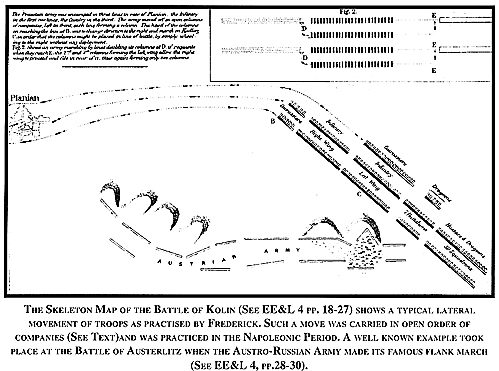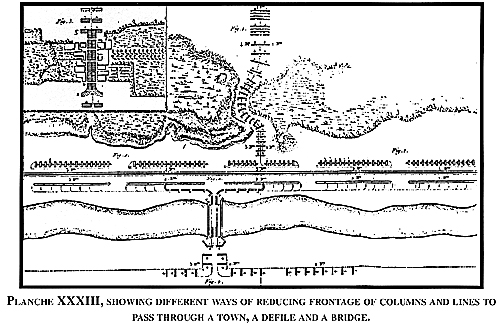In the Wargame Problems section, the EE&L Staff intend to answer questions and/or tactical questions related to wargames. Please send your questions or comments directly to the EE&L Staff.
1. QUESTION ON THE MOVEMENT OF LARGE FORMATIONS ON A BATTLEFIELD
by ROBERT HUTCHINSON
My question is based on the assumption of a relatively large battle with the opposing forces facing each other over a frontage of two or more miles. In situations like this, front line or reserve formations may be transferred fairly long distances in the course of the battle. Two cases which come to mind are Waterloo where French reserves were moved to the far right of the initial French deployment to meet the threat of Prussian forces arriving in the late afternoon and, if memory serves, at Eylau where formations on the extreme French right were transferred to the extreme left as the bulk of Davout's corps came onto the field. My question is, in situations such as this, were previously deployed formations reformed into a column of route in order to make these relatively long distance moves? Related to this, was there a standard doctrine for the formation in which reserves were deployed? Here, I am referring to reserves in a grand tactical rather than a tactical sense, and I supposes French Guard formations would be the most obvious example. I would assume such formations were deployed in columns of companies. Is this a safe assumption?
II. A PARTIAL ANSWER TO ABOVE QUESTIONS BY THE EE&L STAFF
Beside the evolutions provided by the different drill regulations, we are not aware of any specific standard doctrine to deploy reserves. Reserves were simply deployed like any other large basic tactical units such as brigades or divisions. Deployment is by seniority as was shown in a lecture on deployment presented by our group at Historicon 93 (to be published in a future additional newsletter presently in gestation). As a general rule, when close to the enemy:
(1) Deployed reserve units did not reform into column of route unless enough space was not available for the battalions to move in larger formations such as columns of divisions or of companies. (For instance lateral moves on a narrow road or the like.)
(2) reserve units moved, like any other units, in formations as close as possible to the prescribed battle formations, and reduced frontage only to pass obstacles (hill, river, etc.). This is shown on Planche XXXIII of the French Reglement of 1791.
(3) Units could also move in line or some kind of a column (preferably in closed or open columns of companies and that since Frederick's days) to move laterally as shown on the skeleton map of the Battle of Kolin (see also the Leuthen map in EE&L 4 p.22 in the article on Frederick's Oblique Order). Note that moving troops in that fashion was practiced during the Napoleonic period (by the Austro-Russians at Austerlitz, Lannes at lena, etc.)
(4) Also troops could change front as per the Reglement of 1791 [1] (or other countries similar regulations), etc. That was done by the V Corps at Waterloo to face the Prussian attack on the French right flank at Waterloo.
(5) Finally, troops in column of columns could deploy as per the Reglement of 1791 [2] or as shown in EE&L 4 pp. 1-27).
Finally, do not forget that these moves were made out of range of enemy fire. Movements of reserves under enemy fire were rarely successful.
So, in conclusion, there were no set rules to move and engage reserves. It simply depended on the circumstances and on the nature of the ground.
You are right to assume that the French Imperial Guard - circumstances and terrain permitting - moved in columns of companies. [3] Note that the Imperial Guard always entered a battlefield with the left ahead, i.e. with the junior units leading and the Old Guard entering last.
At Eylau, Davout's IIIrd Corps did not move from the extreme French right to the left, but entered the battlefield from the south. At 2 p.m., on the 7th, Davout had received from Berthier the order to form his troops in columns (type not specified) on the road from Bartenstein to Eylau, and to halt his columns 4 miles from Eylau.
The 2nd Division, the closest to Eylau turned right for Zohlen (hence taking the lead instead of the 1st Division) and took position on the road between Beisleiden and Persuschen. The 1st Division now behind the 2nd Division spent the night at Zohlen. The 3rd Division was sufficiently far in the rear to wheel right at a junction where a road led to Bartenstein. That Division bivouacked beyond Bartenstein on the Eylau road.
During the night of February 7/8th, 1807, Davout with his headquarters at Beisleiden [4] received the order to move before day break to join the IVth Corps and attack the enemy's left flank. He was informed that the Russian army was holding a position with his left on the village of Serpallen.
Davout's three Divisions were ordered to march two hours before dawn. Because of roads problems, as seen above, the deployment seniority was not observed. [5] Marulaz cavalry marched first followed by the 2nd Division, heading directly for Serpallen. The 1st Division marched next, joining the Eylau road at Perguschen. Then last came the 3rd Division.
The pertinent point is that Davout formed his troops on the 7th from columns of route into columns (type not specified) obviously to be in a position to repulse the Russians if attacked.
The above answers are far from being exhaustive on the subject, but provide the basic pertinent points raised by Mr. Hutchinson. Some of the above points have been covered in past issues of EE&L 114.
[1]The Reglement of 1791 shows many ways of changing front. For instance Planche XIV, XV are of interest as they are showing changes of directions, etc. Planche XXVIII shows the deployment of 6 battalions into line from a column of battalions in open columns of companies.
Maps
TOP MAP: THE SKELETON MAP OF THE BATTLE OF KOLIN (SEE EE&L 4 pp. 18-27) SHOWS A TYPICAL LATERAL MOVEMENT OF TROOPS AS PRACTISED By FREDERICK. SUCH A MOVE WAS CARRIED IN OPEN ORDER OF COMPANIES (SEE TEXT) AND WAS PRACTICED IN THE NAPOLEONIC PERIOD. A WELL KNOWN EXAMPLE TOOK PLACE AT THE BATTLE OF AUSTERLITZ WHEN THE AUSTRO-RusSIAN ARMY MADE ITS FAMOUS FLANK MARCH (SEE EE&L 4, PP.28-30).
ENDNOTES:
[2]a shown in Planche XXVIII.
[3]The Guard infantry was organized in 4 companies and formed only columns of companies.
[5] The data is from the Operations du 3eme Corps, 1806-1807, pp. 15 8-9 Paris, 1896.
[5] It should have been, Marulaz, 1st Division followed by the 2nd Division and finally the 3rd Division.

PLANCHE XXXIII, SHOWING DIFFERENT WAYS OF REDUCING FRONTAGE OF COLUMNS AND LINES TO PASS THROUGH A TOWN, A DEFILE, AND A BRIDGE.

Back to Empire, Eagles, & Lions Table of Contents Vol. 2 No. 6
Back to EEL List of Issues
Back to MagWeb Master Magazine List
© Copyright 1994 by Emperor's Headquarters
This article appears in MagWeb (Magazine Web) on the Internet World Wide Web.
Other military history articles and gaming articles are available at http://www.magweb.com
